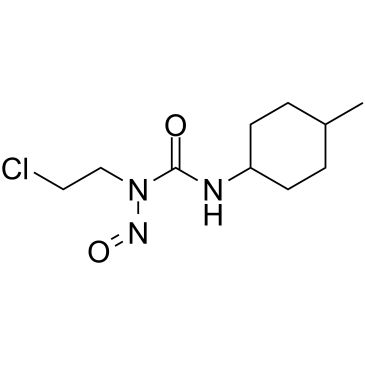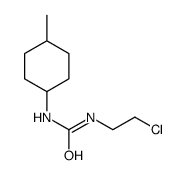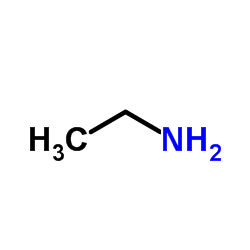Semustine

Semustine structure
|
Common Name | Semustine | ||
|---|---|---|---|---|
| CAS Number | 13909-09-6 | Molecular Weight | 247.72200 | |
| Density | 1.31 g/cm3 | Boiling Point | N/A | |
| Molecular Formula | C10H18ClN3O2 | Melting Point | 64°C (rough estimate) | |
| MSDS | Chinese USA | Flash Point | N/A | |
| Symbol |


GHS06, GHS08 |
Signal Word | Danger | |
Use of SemustineSemustine is a DNA alkylator, binds to DNA, and acts as a cancer chemotherapeutic agent[1]. |
| Name | semustine |
|---|---|
| Synonym | More Synonyms |
| Description | Semustine is a DNA alkylator, binds to DNA, and acts as a cancer chemotherapeutic agent[1]. |
|---|---|
| Related Catalog | |
| References |
| Density | 1.31 g/cm3 |
|---|---|
| Melting Point | 64°C (rough estimate) |
| Molecular Formula | C10H18ClN3O2 |
| Molecular Weight | 247.72200 |
| Exact Mass | 247.10900 |
| PSA | 61.77000 |
| LogP | 2.88780 |
| Index of Refraction | 1.51 |
| InChIKey | FVLVBPDQNARYJU-UHFFFAOYSA-N |
| SMILES | CC1CCC(NC(=O)N(CCCl)N=O)CC1 |
CHEMICAL IDENTIFICATION
HEALTH HAZARD DATAACUTE TOXICITY DATA
MUTATION DATA
|
| Symbol |


GHS06, GHS08 |
|---|---|
| Signal Word | Danger |
| Hazard Statements | H300-H311-H315-H319-H331-H335-H350-H360 |
| Precautionary Statements | P201-P261-P264-P280-P301 + P310-P305 + P351 + P338 |
| Personal Protective Equipment | Eyeshields;Faceshields;full-face particle respirator type N100 (US);Gloves;respirator cartridge type N100 (US);type P1 (EN143) respirator filter;type P3 (EN 143) respirator cartridges |
| Hazard Codes | T: Toxic; |
| Risk Phrases | R45 |
| Safety Phrases | 53-22-26-36/37/39-45 |
| RIDADR | UN 3249 |
| WGK Germany | 3 |
| RTECS | YS5000000 |
| Packaging Group | II |
| Hazard Class | 6.1(a) |
| HS Code | 2924299090 |
| HS Code | 2924299090 |
|---|---|
| Summary | 2924299090. other cyclic amides (including cyclic carbamates) and their derivatives; salts thereof. VAT:17.0%. Tax rebate rate:13.0%. . MFN tariff:6.5%. General tariff:30.0% |
|
Control of bull sperm cell volume during epididymal maturation.
Reprod. Fertil. Dev. 21(3) , 469-78, (2009) Mature spermatozoa have a mechanism by which they can reduce cellular swelling caused by hypo-osmotic stress. The development of this ability during epididymal maturation in the bull was investigated.... |
|
|
Multiparameter MRI assessment of normal-appearing and diseased vertebral bone marrow.
Eur. Radiol. 20(11) , 2679-89, (2010) To evaluate spin-lattice (T1) and spin-spin (T2) relaxation times as well as apparent diffusion coefficients (ADCs) of the fat and water components in the vertebral bone marrow (vBM) of patients with ... |
|
|
Surveillance renal transplant biopsies and subclinical rejection at three months post-transplant in pediatric recipients.
Pediatr. Transplant. 11(5) , 536-9, (2007) Subclinical acute rejection (SCR) has been increasingly recognized in adult renal transplant recipients with the advent of surveillance biopsies. However, in children, surveillance biopsies are not ro... |
| SEMUSTINE |
| 1 (2 chloroethyl) 3 (trans 4 methylcyclohexyl) 1 nitrosourea |
| MFCD00133811 |
| N-<2-chloroethyl>-N'-<4-methylcyclohexyl>-N-nitrosourea |
| trans-ure |
| 1-(4-trans-methylcyclohexyl)-3-(2-chloroethyl)-3-nitrosourea |
| ICIG 1110 |
| Semustin |
| Me-CCNU |
| 1-(2-chloroethyl)-3-(4-trans-methylcyclohexyl)-1-nitrosourea |
 CAS#:13908-15-1
CAS#:13908-15-1 CAS#:6321-23-9
CAS#:6321-23-9 CAS#:64-17-5
CAS#:64-17-5 CAS#:75-04-7
CAS#:75-04-7